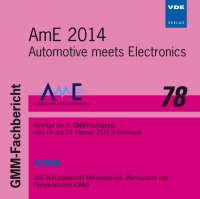Current Switch and Sense Module for the intelligent power distribution in future E-/E-architectures
Konferenz: AmE 2014 – Automotive meets Electronics - Beiträge der 5. GMM-Fachtagung
18.02.2014 - 19.02.2014 in Dortmund, Deutschland
Tagungsband: AmE 2014 – Automotive meets Electronics
Seiten: 6Sprache: EnglischTyp: PDF
Persönliche VDE-Mitglieder erhalten auf diesen Artikel 10% Rabatt
Autoren:
Fuisting, Manfred; Gillhaus, Rüdiger; Olk, Joachim (HELLA KGaA Hueck & Co., Lippstadt, Germany)
Gauter, Thomas; Völkel, Holger; Falkenstein, Jan (BMW Group, Munich, Germany)
Inhalt:
Today’s electrical onboard energy systems are designed and built hierarchical cascades of power distribution levels. The control of clamp 30 and the protection of the wiring harness are currently realized with relays and fuses. Due to the increase in complexity, as well as concept limited disadvantages, the well-known branching structure reaches a functional limitation regarding stability of the electrical onboard energy system, power dissipation, flexibility and extensibility, geometric integration and weight. In contrast to currently realized electrical onboard energy systems with conventional fuse and relay boxes, intelligent power distribution units based on new semiconductor technologies have many advantages, such as reversible protection with flexible adjustment of fuse characteristics regarding the load profile, improved diagnostic capabilities and improved power management. The integrated approach of architectural optimization on the vehicle level, and new electronic components, creates a potential for weight and cost reduction in the wiring harness, by decentralizing the power supply and the possibility to reduce the cross section and the length of the electrical wires. The focus of this paper is to present intelligent power distribution units, by name “Current Switch and Sense Modules” (CSSM), which combines wiring protection and switching functions in one device. This approach has been developed scalable for two different current ranges and has been realized with first prototypes. Based on the defined requirements for hardware, contact systems, software and thermal performance, concepts have been developed with current available technologies. A power supply, fuse protection and switching up to 150A per output channel is feasible. Optimization criteria for intelligent power distribution units and the associated semiconductor technology are also presented in this paper. The achieved results show that the realization of fully electronical power distribution units has become a feasible goal for the next generation of vehicles.


